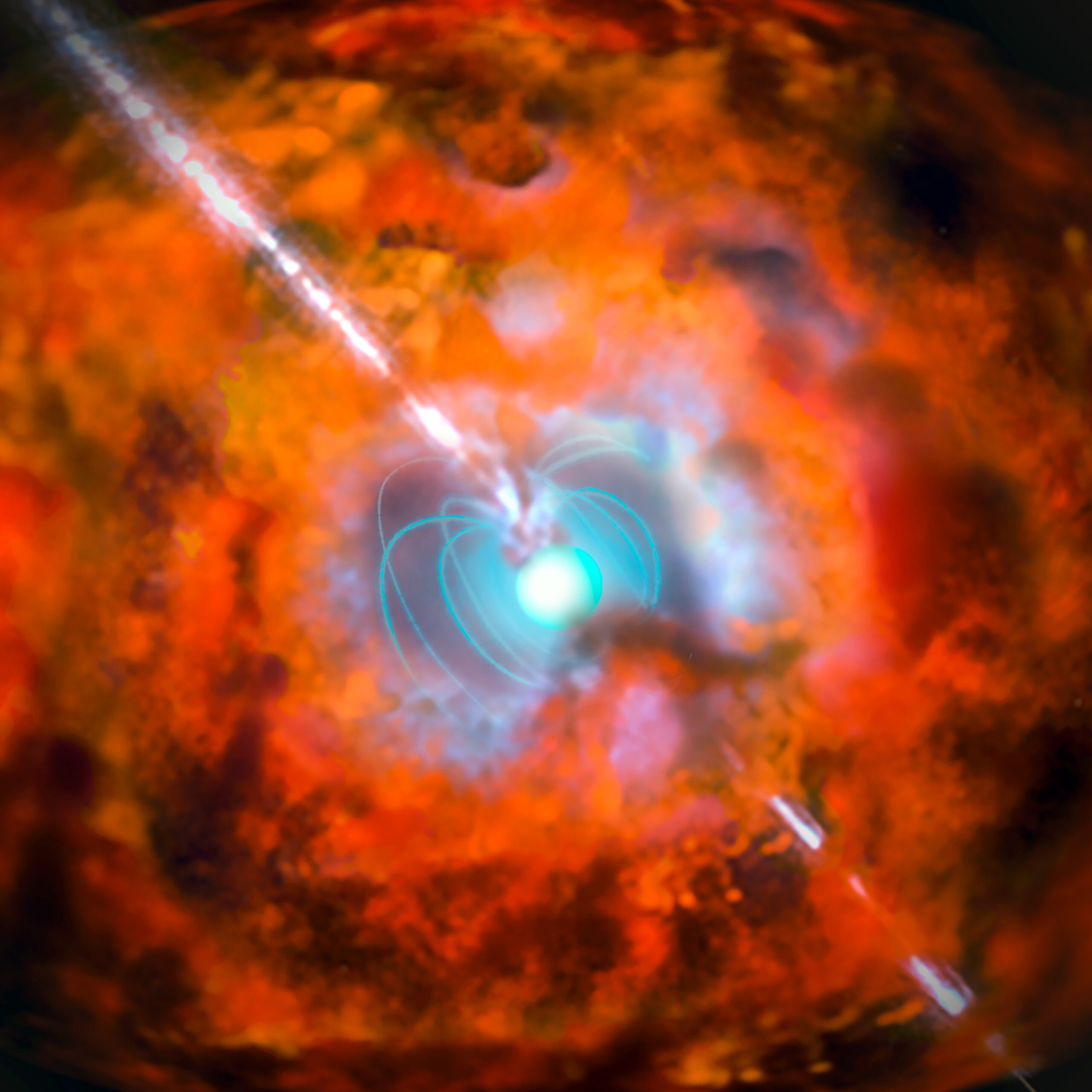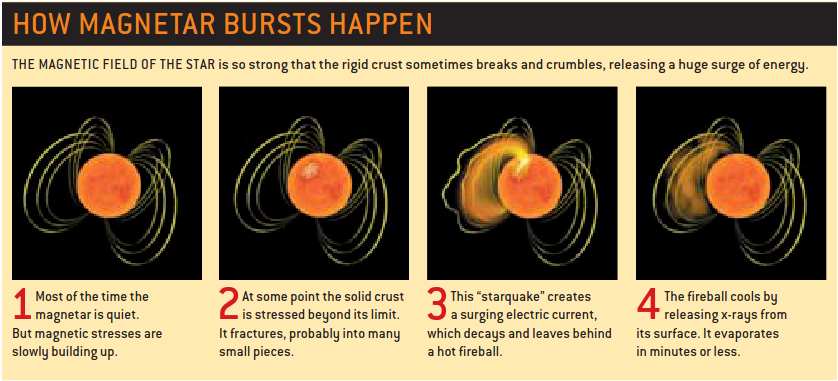A Magnetar is a type of neutron star with an extremely powerful magnetic field (~109 to 1011 T, ~1013 to 1015 G). The magnetic-field decay powers the emission of high-energy electromagnetic radiation,
particularly X-rays and gamma rays.

Like other neutron stars, magnetars are around 20 kilometres (12 mi) in diameter, and have a mass of about 1.4 solar masses. They are formed by the collapse of a star with a mass 10–25 times that of the Sun. The density of the interior of a magnetar is such that a tablespoon of its substance would have a mass of over 100 million tons.Magnetars are differentiated from other neutron stars by having even stronger magnetic fields, and by rotating more slowly in comparison. Most observed magnetars rotate once every two to ten seconds, whereas typical neutron stars, observed as radio pulsars, rotate one to ten times per second. A magnetar’s magnetic field gives rise to very strong and characteristic bursts of X-rays and gamma rays. The active life of a magnetar is short compared to other celestial bodies. Their strong magnetic fields decay after about 10,000 years, after which activity and strong X-ray emission cease. Given the number of magnetars observable today, one estimate puts the number of inactive magnetars in the Milky Way at 30 million or more.
The dominant model of the strong fields of magnetars is that it results from a magnetohydrodynamic dynamo process in the turbulent, extremely dense conducting fluid that exists before the neutron star settles into its equilibrium configuration. These fields then persist due to persistent currents in a proton-superconductor phase of matter that exists at an intermediate depth within the neutron star (where neutrons predominate by mass). A similar magnetohydrodynamic dynamo process produces even more intense transient fields during coalescence of pairs of neutron stars. An alternative model is that they simply result from the collapse of stars with unusually strong magnetic fields.
According to the National High Magnetic Field Laboratory of Florida State University, a fridge magnet is about 0.001 tesla.
To put that in perspective, the Earth’s magnetic field is about 0.00005 tesla and an average MRI magnet measures 1.5 tesla.
The vast majority of known magnetars were discovered via their short X-ray bursts, thanks to sensitive all-sky monitors like the Burst Alert Telescope (BAT) aboard Swift and
the Gamma-ray Burst Monitor (GBM) aboard Fermi. These instruments were designed to study gamma-ray bursts so are fine-tuned to finding brief, bright bursts over the full sky.
Magnetars are also thought to be the cause of some fast radio bursts (FRBs), powerful but brief eruptions of radio waves that observers have found emanating from mysterious sources scattered across the universe. How magnetars might produce FRBs is uncertain, yet systems like HD 45166 could offer useful clues for solving the puzzle. “We have at least one case where an FRB source might be in a binary system,” Hessels says, noting a potential linkage between the phenomenon and systems like HD 45166.

At their sources, fast radio bursts have a lot of energy: In a millisecond, some FRBs can blast out as much energy as the sun emits in three Earth days. Because they come from billions of light-years away, however, FRBs lose energy as they travel, so when they reach Earth, they are much less powerful. When radio telescopes spot FRBs from Earth, the strength of the signal is similar to a mobile phone signal from the moon.
Magnetar J1818.0-1607
Swift J1818.0-1607 is a new radio-loud magnetar discovered by the Swift Burst Alert Telescope on 2020 March 12.
It has a magnetic field B [~2.514 G]
{250 trillion Gauss} or [25,000,000,000 T]
With a spin-down luminosity of [ 7.235 ergs/s ] , and characteristic age of ~470 yr.
Remember that luminosity is the total amount of energy produced in a star and radiated into space in the form of E-M radiation.
The Sun radiates 3.9 x 1033 ergs/sec.
1 joule (J)
= 1 wattsecond
= 1 x 107 erg
= 0.2388 gramcalories
One tesla (T) is equal to 10,000 gauss (G) or 1 gauss =0.0001 Tesla.